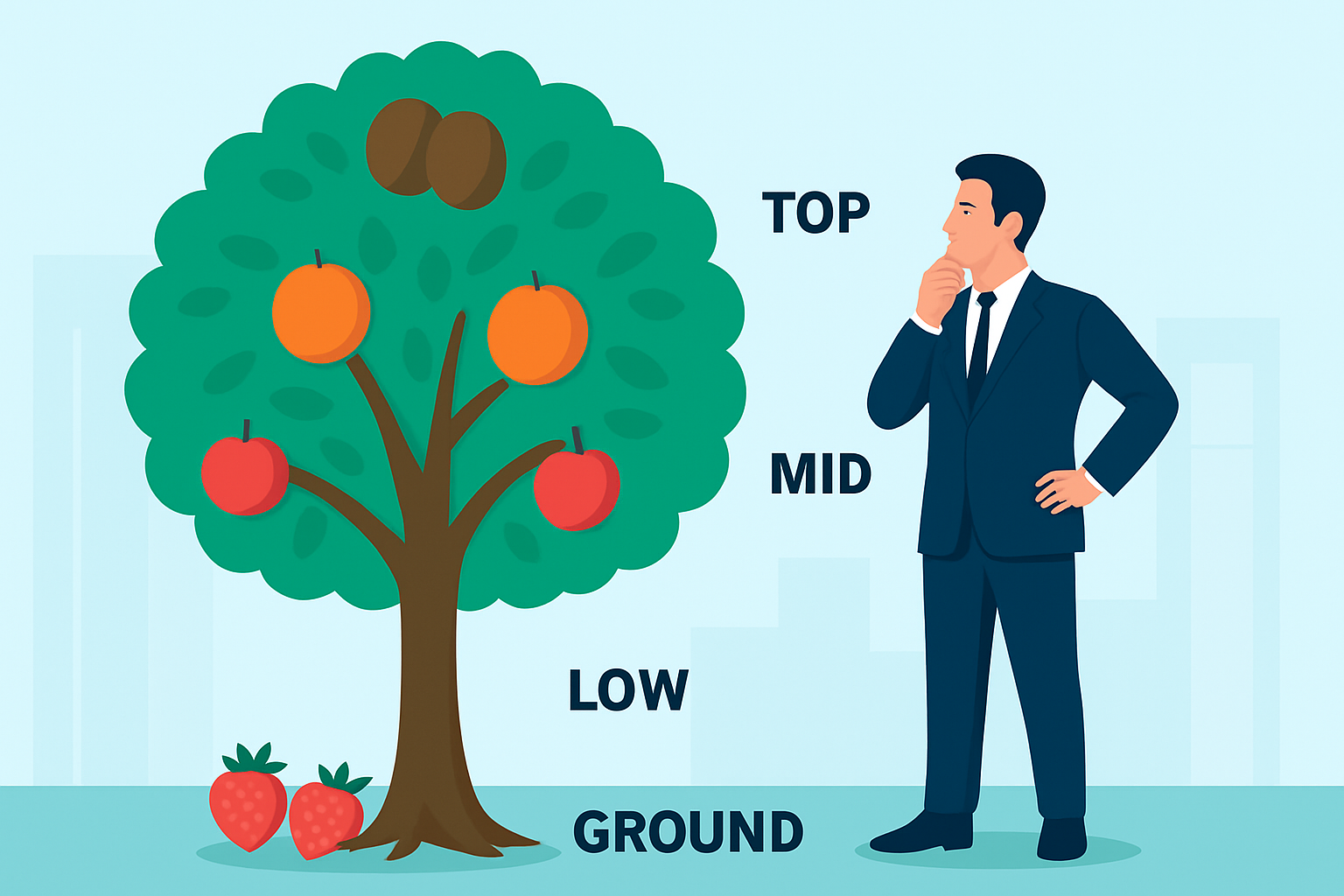
This month, I was qualifying my accounts for next year and hit the same wall every sales professional knows: “high, medium, low potential” tells you nothing about what to actually DO.
So I created something different. Something that works in team meetings AND boardroom presentations. Something that’s already changing how I approach my entire territory.
I call it the “Fruit Level Framework” – and here’s why it might revolutionize how your organization thinks about account qualification.
I realized classifying accounts as just “high, medium, low potential” wasn’t enough.
That tells me nothing about how hard they’ll be to win, what to do about it, or when to act. So I created something I call the “Fruit Level Framework” – but here’s what I learned: it needs two faces to work in the real world.
The Dual Identity Solution
🍎 The Informal Version (Team Meetings & Training) Perfect for coaching, team discussions, and making it stick. People remember “don’t break your neck for coconuts” better than “avoid high-effort, low-value opportunities.” (or maybe they don’t, what do you say?).
📊 The Enterprise Version (Boardrooms & CRM Integration) Same framework, formal language. “Dynamic Account Prioritization Matrix” with measurable inputs and business metrics.
The Complete Framework
Step 1: Pick Your Lens The same account looks different depending on your timeframe, solution you are offering, joint opportunities, and your own mindset for that matter – be picky about your lens and make sure you stick to it when you qualify:
- Q4 close lens? That Tree Crown deal becomes “walk away”
- 2026 planning lens? Same deal might be “invest & nurture”
- Territory development lens? Could be your strategic foundation
As this is a framework, you can make your own variation of it to fit your situation, just make sure to stick to the principles of the framework.
Step 2: Apply the Classification Matrix
Informal (Fruit) Version – the fun one:
- 🍓 Ground Level + High Potential = GRAB FAST (your quarterly heroes)
- 🍓 Ground Level + Low Potential = QUICK WINS (fill pipeline gaps)
- 🍎 Low Hanging + High Potential = PRIORITIZE (your sweet spot)
- 🍎 Low Hanging + Low Potential = EFFICIENT HARVEST (batch process these)
- 🍊 Mid Hanging + High Potential = INVEST & NURTURE (plan your ladder strategy)
- 🍊 Mid Hanging + Low Potential = SELECTIVE PICK (only if you have capacity)
- 🥥 Tree Crown + High Potential = STRATEGIC CLIMB (limit to 2-3 max)
- 🥥 Tree Crown + Low Potential = WALK AWAY (don’t break your neck)
Enterprise Version – the almost as fun one:
- Transactional + High Value = Accelerate
- Transactional + Low Value = Process Efficiently or disqualify
- Tactical + High Value = Focus Resources
- Tactical + Low Value = Batch Process
- Strategic Growth + High Value = Develop & Invest
- Strategic Growth + Low Value = Selective Engagement
- Transformational + High Value = Strategic Initiative (limited capacity)
- Transformational + Low Value = Disqualify
Step 3: Account Type & Final Judgement From my field testing, I added two critical parameters or columns if you want (man the dev in my shines through):
1 – Hunt Classification:
- Existing/Expansion accounts vs New Logo/Hunt opportunities
- Changes your approach and timeline expectations
2 – Judgement Column: The sanity check. Regardless of where the matrix puts it – do we actually want this account? Sometimes the data says yes but your gut says no. Trust both.
Step 4: Remember – Fruit Ripens Accounts evolve. That Mid Hanging deal today could be Ground Level next quarter when their contract expires. Your Tree Crown prospect might drop to Low Hanging when your driver/champion gets promoted.
Context Is Everything
From my perspective, a $50K deal might be Low Potential. For services, that same account could be High Potential if it opens a $500K annual relationship. The framework adapts to YOUR context. Be sure to use it wisely and maybe look for joint opportunities.
If you want to go fast, go alone; if you want to go far, go together
African proverb
Making It Work
- For Individual Reps: Use the fruit version for daily planning and team discussions
- For Enterprise Adoption: Present the matrix version with scoring rubrics and CRM integration
- For Training: Start with fruit metaphors, then introduce the formal classifications
I’ve been field-testing this on my actual account list, and the Hunt/Judgement additions have been game-changers for real-world qualification decisions.
What’s your take? Does your organization need the fruit version, the enterprise version, or both?

One Response